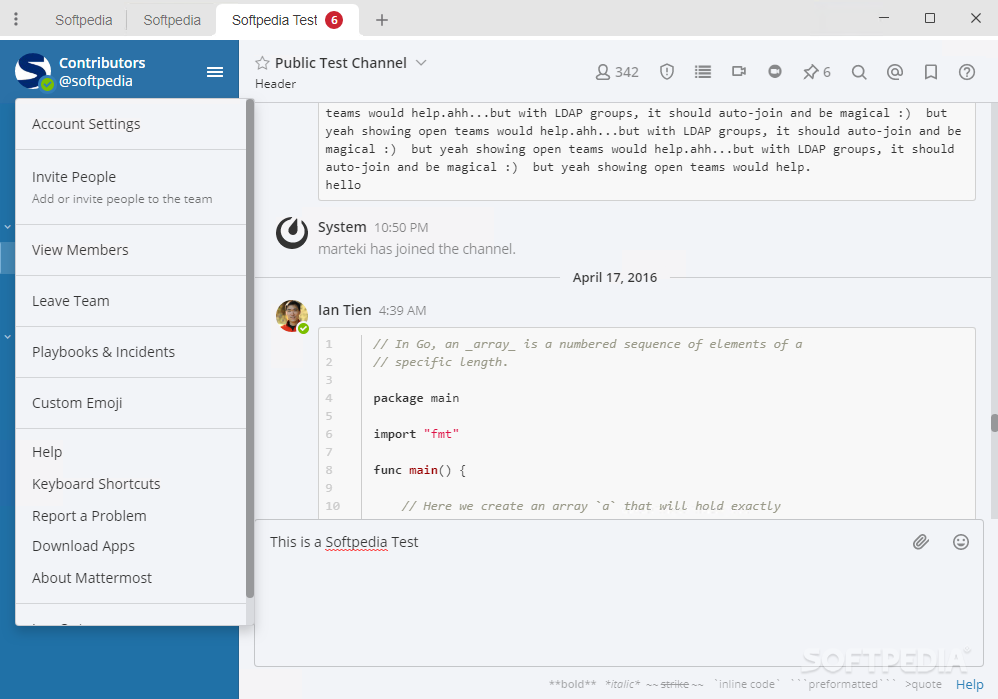


Test the response of opening your Mattermost team site on your phone’s mobile browser.Test the response of your iOS or Android app as compared to the above benchmarks.If they are significantly higher, move to an area with better reception or contact your wireless provider to correct any technical issues.Ĭonfirm your mobile app is performing properly Check if your ping time (a measure of signal latency) to see if it’s similar to the benchmarks in the above section.From your mobile browser go to, download the SpeedTest app and begin a test.Please confirm the device you’re testing meets the minimum operating system and hardware requirements of Mattermost Mobile Apps.Ĭonfirm your mobile device connection is on 4G/LTE or Wifi and meets ping time requirements.If your mobile app is not performing to these sample benchmarks, you can identify bottlenecks using the following process:Ĭonfirm your mobile device meets minimum hardware and operating system requirements Removing bottlenecks to mobile app performance ¶ Note: While Mattermost mobile applications may be used on 3G (and lower) connections, this configuration is not recommended. Fresh start of the app until first page load: less than 4 seconds.Samsung Galaxy S6 on wifi connection (23 ms ping time, 138 Mb/s download, 12 Mb/s upload): Samsung Galaxy S6 on 4G/LTE connection (23 ms ping time, 36 Mb/s download, 17 Mb/s upload): Fresh start of the app until first page load: less than 5 seconds.Switching to the app and loading a channel after the phone has been asleep: less than 3 seconds.Loading a new channel: less than 3 seconds.IPhone 5s on 5G connection (20 ms ping time, 77 Mb/s download, 12 Mb/s upload): Fresh start of the app until first page load: less than 10 seconds.Switching to the app and loading a channel after the phone has been asleep: less than 5 seconds.Switching to app when it is running in the background: less than 1 second.Returning to a channel previously viewed: less than 1 second.Loading a new channel: less than 4 seconds.IPhone 6s Plus on 4G/LTE connection (50 ms ping time, 50 Mb/s download, 8 Mb/s upload): Properly configured mobile applications on 4G/LTE or wifi should perform as follows: The APNS or GCM service confirms that the message from the Mattermost Push Notification Service is authorized for the target mobile application and forwards the message to the app to be displayed.The message from the Mattermost Push Notification Service is signed with a key that’s registered with the recieving service, corresponding to the target mobile app, so its authenticity is verified. The Mattermost Push Notification Service forwards the message to either Apple Push Notification Service (APNS) or to the Google Cloud Messaging (GCM) service depending on whether you’re sending to an iOS or Android device.When triggered, a push notification is sent from the Mattermost server to the Mattermost Push Notification Service over TLS.To ensure only push notifications from authorized senders are processed by iOS and Android mobile application, each push notifications need to come from a trusted source.

What happens when a Mattermost push notification is sent? ¶ Mattermost Android App on Google Play with encrypted push notificationsĪ license key to activate HPNS is available with a subscription to Mattermost Enterprise Edition.Īfter purchasing and installing a license key, you can turn on HPNS using System Console > Notifications > Mobile Push > Send Push Notifications > Use encrypted, production-quality HPNS connection to iOS and Android apps.Mattermost iOS App on iTunes with encrypted push notifications.With HPNS, end users can use publicly available iOS and Android mobile applications on iTunes and Google Play over encrypted connections: offers a Hosted Push Notification Service (HPNS) via commercial subscription for organizations who want encrypted push notifications sent from behind their firewall, with production-quality uptime and commercial support, as an alternative to compiling, deploying and securing their own service from source code provided (see “Enterprise App Store” in next section). Hosted Push Notifications Service (HPNS) ¶


 0 kommentar(er)
0 kommentar(er)
